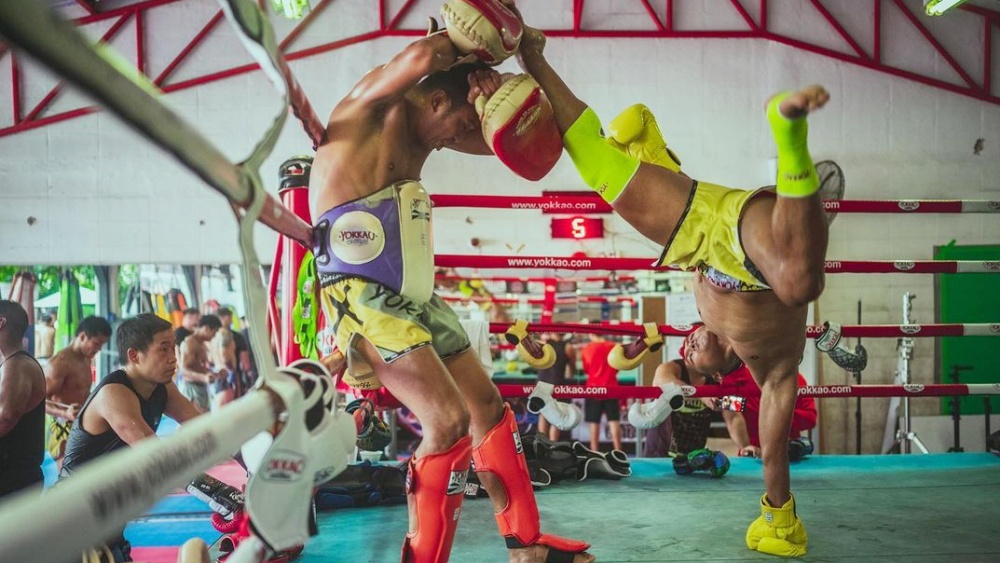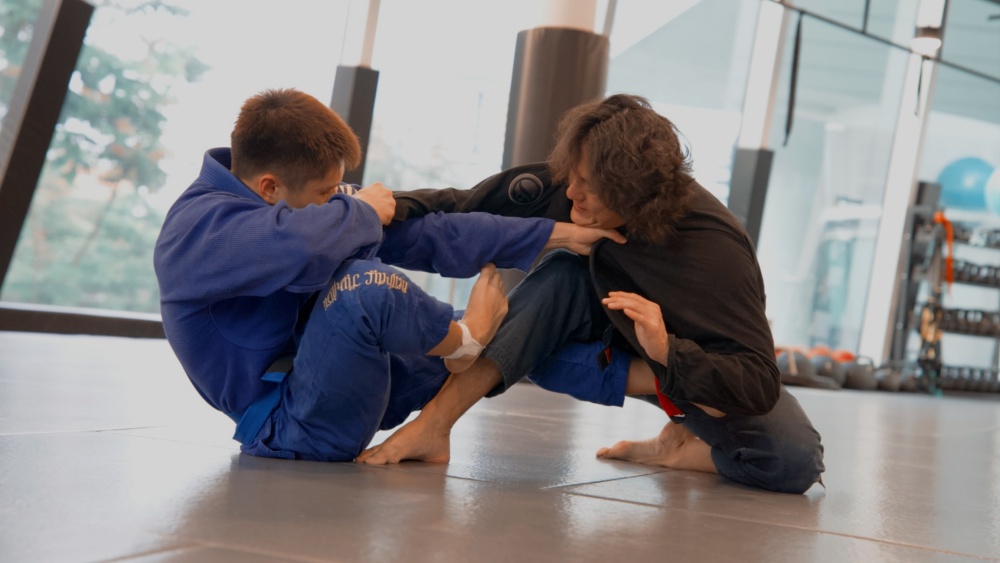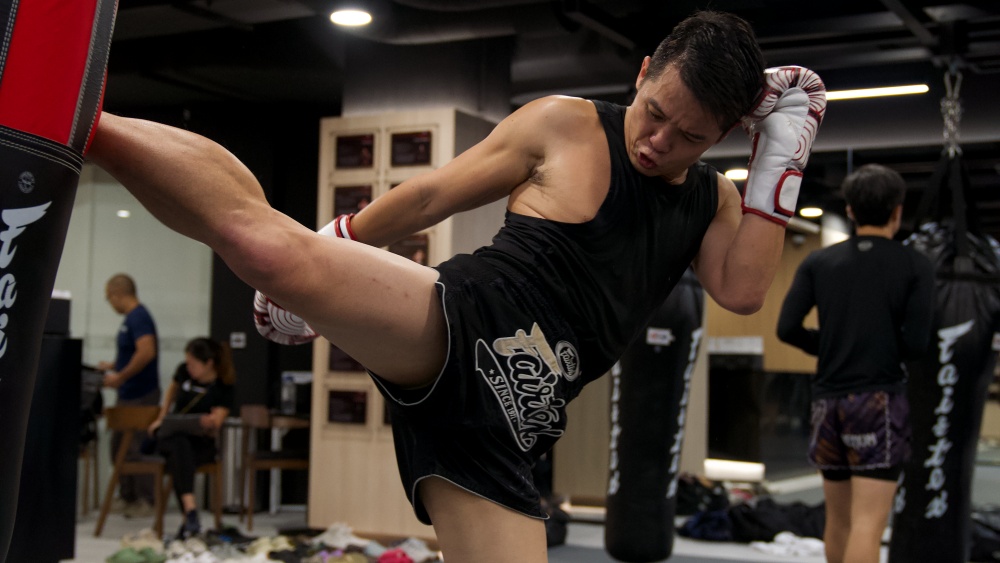The cartwheel kick was a unique and innovative technique that became extremely popular in Muay Thai in the early 2000s. Though it has since been banned in professional competition it is still an incredibly fun skill to learn and play with during friendly bouts of sparring. In this article, we’re going to give you everything you need to know about the cartwheel kick. We’ll give you a rundown on the move’s invention and history leading up to its inevitable ban from most professional competition. Then, we’ll break down the technique into basic steps, just in case you feel like practicing it the next time you are having some fun, light sparring rounds in the gym with your friends.
The History Of The Cartwheel Kick
Whenever the cartwheel kick is mentioned, it is most commonly alongside the name, “Saenchai.” The legendary Muay Femur popularised the kick in the early 2000s, delivering the trademark consistently on the famous Thai Fight promotion. Inspired by the legend, Nak Muays around the world soon followed suit and before long just about every Muay Thai promotion around the globe featured at least one copycat fighter attempting to replicate the unorthodox technique with varying levels of success.
Though many people attribute this kick’s invention to Saenchai, the cartwheel kick was around long before he was born. It is a traditional Muay Boran technique called “The Horse Flicks The Skull” or simply, “The Horse Kick” depending on which translation you use. This move fell out of fashion in the 1930s when Muay Boran/Kard Chuek was modernized with the use of gloves and boxing rings. According to acclaimed fighter and Muay Thai historian, Sylvie Von Douglas-Ittu, Saenchai wasn’t the first fighter to re-introduce the cartwheel kick back into the modern arena. Apparently, the first recorded use of the cartwheel kick in modern Muay Thai can be attributed to Golden Era fighter and 2x Rajadamnern stadium champion, Rotnarong Wor.Watthana but without video evidence to back this claim, most still regard Saenchai as the man who unearthed this long-forgotten technique.
Surprisingly, Saenchai claims that his inspiration for the kick didn’t come from either Muay Boran or Rotnarong himself. He claims to have seen a similar kick used in Sepak Takraw, a Southeast Asian game of Kick-Volleyball, and simply adopted it into his own skillset.
Why Don’t You See The Cartwheel Kick Anymore?
The Cartwheel Kick’s rise to fame and subsequent fall into obscurity happened fairly quickly. This is because most Muay Thai stadiums and governing bodies were quick to update their rules, classifying the kick as a foul.
In Muay Thai, it is illegal to strike a downed opponent. That is, the second any part of a fighter’s body other than their feet touches the canvas, the other fighter must stop action until they are back on their feet and the referee calls for the bout to resume. Since this technique involves a fighter intentionally “downing” themselves it was deemed unfair to use because, if a fighter isn’t allowed to strike their downed opponent, then a downed fighter shouldn’t be allowed to strike them either.
4 Steps To Throwing A Cartwheel Kick
1) Learn How To Cartwheel
While the technique for a cartwheel kick is a little different, and possibly harder as it only uses one hand, you should walk before you run and practice the generic cartwheel so that you can get used to flipping yourself upside down. The above video gives you an idea of how to do a basic cartwheel and provides tips for modifying it if you have trouble doing the full movement straight away.
2) Shoot Your Lead Hand Onto The Floor
While the rotation involved in a cartwheel kick is inherently similar to that of the standard gymnastics cartwheel, it is done with only one hand connected to the floor. Shoot your extended lead hand down in front of you so that your knuckles land on the canvas outside of your lead foot.
Making sure that your hand is outside of your foot not only makes it easier to throw your weight through your opponent on the incoming kick, but it’s also safer. You don’t want to accidentally lunge your face directly into one of your opponent’s incoming knees, so throwing yourself off center helps to get you out of the line of fire. Watch the demonstration of steps 2 and 3 in the above from Shane from FightTips.
3) Vault Your Legs Overhead
With your head down and your grounded arm held out straight, vault your legs up and overhead. As you do this, bend your lead leg whilst keeping your rear leg out straight so you have the maximum range for the kick.
4) Turn Through Your Opponent
Unlike the conventional cartwheel in which your legs travel directly overhead, the cartwheel kick still requires a little bit of outward rotation so that you are kicking through your opponent’s head rather than having your foot come down on top of them. The above video of Saenchai, teaching this kick to a student, shows the route you should travel in detail.
Remember: Timing Is Everything!
The cartwheel kick is a complex movement that is easily seen and countered if you just throw it on a whim. So, if you don’t want to wear a solid teep to your body, or worse, a kick to the head whilst you are inverted on the canvas, you need to make sure that you look for the right opportunity to throw it.
One of the simplest and best setups for a cartwheel kick comes from the common catch-and-throw kick exchanges that you will often fall into during competitive sparring rounds. Throw your hand to the mat to cartwheel immediately after you catch a kick and throw it across your body. Your opponent will be off balance and will fall directly into your incoming shin, doubling your power whilst also making it difficult for them to defend, even if they do see the kick coming.
Conclusion
Though popularised by Saenchai, the cartwheel kick’s history can be traced back to Muay Thai’s predecessor, the ancient art of Muay Boran. Even though it has been banned from competition it is still a fun technique to learn and play with during light rounds of sparring with friends. But, while the reward that comes from landing one is high, the risk involved in this easily defended kick is higher, so make sure to get plenty of practice and look for the right opportunities before you decide to flip yourself upside down in the middle of the ring.
You may also like:

















